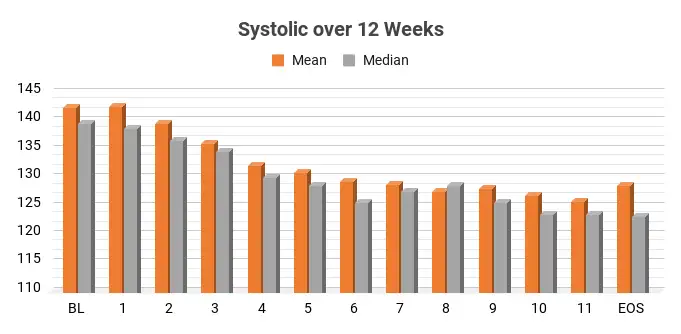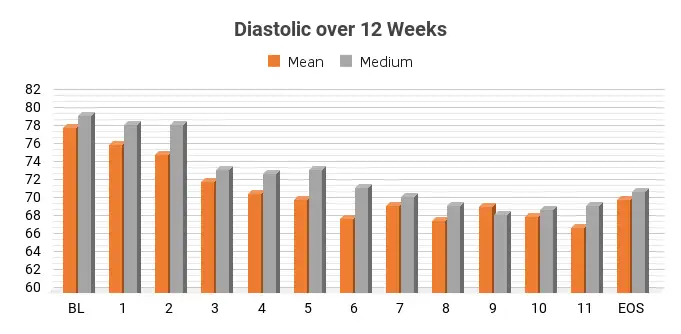Clinical Trial Results of eBalance®
In a study approved by Health Canada, eBalance® underwent a rigorous 12-week observational clinical trial, focusing on its efficacy and safety for diabetic patients.
Thirty participants, all diagnosed with diabetes, were selected to partake in this study twice weekly for fifteen minutes per treatment. The objective was clear: to observe and record the effects of eBalance® on key health parameters, including blood pressure, plasma insulin levels, and fasting blood sugar levels.
Here are the findings that mark a significant milestone in anti-aging, diabetic care and electroceutical intervention.
Blood Pressure (Hypertension)
The trial demonstrated a promising trend towards the reduction of blood pressure among the participants. Both systolic and diastolic blood pressure readings showed a mean decrease from the baseline measurement with a mean of 142 mmHg and 78 mmHg respectively to a measurement at end of study with a mean of 128 mmHg and 70 mmHg.
Notably, this decrease was not abrupt but followed a gradual trajectory, with the most significant changes observed from weeks one through seven.
Post the seventh week, the decrease in blood pressure plateaued, maintaining a steady and improved state until the study’s conclusion at week twelve. This pattern indicates not just an immediate response to the treatment but also its sustained efficacy over time.


Blood Pressure Analysis (30 participants)
| Status |
Baseline (Pre-Trial) |
End of Study (EOS) |
| Over 140/90 mmHg |
18 (60%) |
7 (23%) |
| Under 140/90 mmHg |
12 (40%) |
23 (77%) |
Blood Pressure Trend at End of Study (EOS)
| Trend |
Number of Subjects |
Percentage |
| Lower at EOS |
24 |
80% |
| Higher at EOS |
3 |
10% |
| Even at EOS |
3 |
10% |
Importance – Maintaining healthy blood pressure is crucial for overall health and well-being, as high blood pressure (hypertension) can lead to serious health issues. Hypertension is often referred to as a “silent killer” because it typically has no symptoms but can cause long-term damage to the body. Here are the key reasons why avoiding high blood pressure is important:
- Prevention of Heart Disease and Stroke: High blood pressure is a leading risk factor for heart disease and stroke.
- Reduction of Kidney Damage: The kidneys are organs that are particularly sensitive to blood pressure levels. Over time, high blood pressure can damage the blood vessels leading to and within the kidneys, impairing their ability to filter blood effectively. This can lead to kidney disease or kidney failure.
- Prevention of Vision Loss: Hypertension can strain or damage blood vessels in the eyes, leading to conditions such as retinopathy, which can result in blurred vision or blindness.
- Avoidance of Sexual Dysfunction: High blood pressure can lead to erectile dysfunction in men and lower libido in women. This is due to the reduced blood flow resulting from narrowed or damaged arteries.
- Protection of Cognitive Functions: High blood pressure is associated with an increased risk of cognitive decline and dementia. It can lead to reduced blood flow to the brain, impacting its ability to function properly.
- Prevention of Peripheral Artery Disease (PAD): Hypertension can lead to the development of PAD, characterized by narrowed arteries in the legs, stomach, arms, and head, leading to pain, numbness, or even infections.
- Reduced Risk of Aneurysm: High blood pressure can cause the blood vessels to weaken and bulge, forming an aneurysm. If an aneurysm ruptures, it can lead to life-threatening internal bleeding.
- Better Quality of Life: Maintaining a normal blood pressure level helps to ensure a better quality of life. It allows individuals to stay active, reduce the need for medications, and decrease the risk of emergency medical situations.
Plasma Insulin
One of the most remarkable outcomes of the study was observed in the plasma insulin levels of the participants. With the baseline average being 168 pmol/L, within the healthy range but close to the upper limit, the treatment exhibited a profound impact.
By the study’s end, the plasma insulin levels had plummeted by an impressive 48%, averaging at 86 pmol/L. This significant reduction underscores the potential of eBalance® in regulating insulin levels.
Plasma Insulin Analysis (24 participants)
Note: Only 24 subjects are included due to insufficient data for 2 subjects and Type I diabetes for 4 subjects..
| Status |
Baseline (Pre-Trial) |
End of Study (EOS) |
| Over 174 pmol/L |
11 (46%) |
4 (17%) |
| Under 174 pmol/L |
13 (54%) |
20 (83%) |
Plasma Insulin Trend at End of Study
| Trend |
Number of Subjects |
Percentage |
| Lower at EOS |
20 |
83% |
| Higher at EOS |
4 |
17% |
Importance – It is important to note that there is research to suggest that lower insulin levels are associated with increased lifespan and improved healthspan, possibly due to reduced metabolic stress and decreased risk of chronic diseases.
In addition, high insulin levels are often associated with increased levels of inflammation in the body, which can lead to chronic diseases. Lowering insulin levels can reduce inflammation and improve overall health. Here are more reasons to reduce high plasma insulin levels:
- Improved Insulin Sensitivity: High plasma insulin levels are often associated with insulin resistance, a condition where cells in the body do not respond well to insulin. Lowering insulin levels can help improve insulin sensitivity, making it easier for the body to manage blood glucose levels.
- Reduced Risk of Type 2 Diabetes: High insulin levels can be a precursor to type 2 diabetes. By lowering these levels, individuals can potentially reduce their risk of developing type 2 diabetes or can better manage the condition if they already have it.
- Weight Management: Insulin plays a significant role in fat storage and metabolism. High insulin levels can lead to increased fat storage and difficulty losing weight. Lowering insulin levels can help in weight loss efforts and improve metabolic health.
- Lower Risk of Cardiovascular Diseases: High insulin levels are associated with an increased risk of cardiovascular diseases. By lowering insulin levels, individuals may reduce their risk of conditions such as heart attack and stroke.
- Improved Hormonal Balance: High levels of insulin can disrupt the balance of other hormones in the body, including sex hormones. This imbalance can lead to conditions such as polycystic ovary syndrome (PCOS) in women. Lowering insulin levels can help restore hormonal balance and alleviate symptoms of such conditions.
- Decreased Inflammation: High insulin levels are often associated with increased levels of inflammation in the body, which can lead to chronic diseases. Lowering insulin levels can reduce inflammation and improve overall health.
Fasting Blood Sugar
Fasting blood sugar levels, a critical indicator of glycemic control, were also meticulously monitored during the trial. Pre-trial, the average fasting blood sugar level of the participants stood at a concerning 10.5 mmol/L, well into the diabetic range.
Over the 12-week period, eBalance® showcased its therapeutic potential by reducing the average fasting blood sugar levels to 9.2 mmol/L a 12% decrease. Although still in the diabetic range, this reduction is indicative of a positive trend and, most importantly, a step towards better glycemic control.
Importance – Maintaining low fasting blood sugar levels is vital for overall health, particularly in preventing and managing diabetes and its associated complications. Here’s why keeping fasting blood sugar levels within a healthy range is important:
- Prevention of Diabetes: Elevated fasting blood sugar levels are a primary indicator of prediabetes. By keeping these levels low, individuals can prevent or delay the onset of type 2 diabetes, a condition characterized by high blood sugar levels due to insulin resistance or lack of insulin production.
- Reduced Risk of Diabetic Complications: For individuals with diabetes, maintaining a low fasting blood sugar helps prevent long-term complications, including kidney disease (nephropathy), nerve damage (neuropathy), eye damage (retinopathy), and cardiovascular diseases.
- Enhanced Energy and Well-being: Stable blood sugar levels help ensure a steady supply of energy to the body’s cells, leading to improved energy levels, better mood, and overall well-being.
- Improved Weight Management: High blood sugar levels can lead to weight gain and difficulty losing weight. Maintaining a low fasting blood sugar level helps regulate appetite and reduce the risk of obesity.
- Protection of Cardiovascular Health: High fasting blood sugar levels are linked to an increased risk of atherosclerosis, where the arteries narrow and harden due to the buildup of plaque. This can lead to heart disease, stroke, and other cardiovascular problems.
- Cognitive Health Preservation: Elevated blood sugar levels have been associated with an increased risk of cognitive decline and dementia, including Alzheimer’s disease. Keeping blood sugar levels in check may help protect brain health.
- Reduced Inflammation: High blood sugar levels can lead to increased inflammation in the body, which is a risk factor for many chronic diseases. Maintaining low fasting blood sugar levels can help reduce this inflammatory response.
- Improved Healing and Recovery: High blood sugar levels can impair the body’s healing process, making recovery from infections, wounds, and surgeries more difficult. Keeping blood sugar levels under control can promote faster and more effective healing.
Safety and Tolerability:
Throughout the 12-week period, eBalance® treatment was observed to be safe for all participants, with no significant adverse events reported. This aspect of the study highlights the device’s potential for safe integration into regular health and wellness routines.
Conclusion:
The clinical trial of eBalance® marks a pivotal advancement in the home management and treatment of aging related complications. With the backing of Health Canada and the promising results from this trial, eBalance® stands at the cusp of transforming wellness treatment paradigms, ushering in a future where electroceutical solutions are a cornerstone of aging management and potentially a crucial factor in enhanced longevity.


